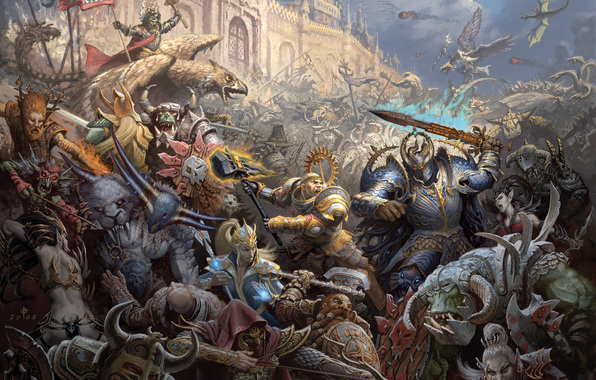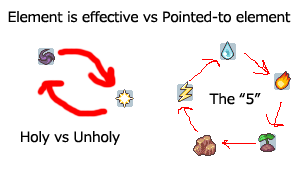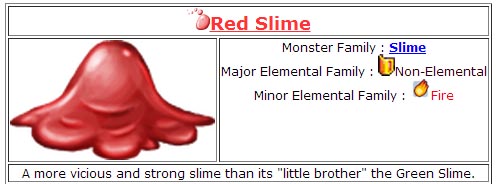This is an old revision of the document!
Table of Contents
 Combat in Godwars is fast-paced and real-time. Whether you want to hands on pay attention and be aware in case of a last second flee when your front line ends or sit back and relax until you hear the victory(or defeat) music are both perfectly good options. Due to the large amount of strategy settings, you will feel far more control over battles than you might expect. By setting up a “front row” of aggressive tanks defending “avoidance” high dps units, you'll literally see your front line clash with the monsters. Below are some of the better details about combat and how it works. It is not required to know but for those of you who want a better understanding, it is provided.
Combat in Godwars is fast-paced and real-time. Whether you want to hands on pay attention and be aware in case of a last second flee when your front line ends or sit back and relax until you hear the victory(or defeat) music are both perfectly good options. Due to the large amount of strategy settings, you will feel far more control over battles than you might expect. By setting up a “front row” of aggressive tanks defending “avoidance” high dps units, you'll literally see your front line clash with the monsters. Below are some of the better details about combat and how it works. It is not required to know but for those of you who want a better understanding, it is provided.
Taking Initiative
Every 6 seconds a player generates “initiative roll”. This is not reflected in combat due to how much text it would create so it is “underneath the hood”.
All initiative rolls are 1 to 400 plus the follower's speed value. When a member has an accumulative initiative value of 400+fatigue modifier, they get an action. Each speed point increases a follower's speed by about 0.25% over the base amount. It is possible to get a large amount of actions over opponents with higher speeds.
Fatigue
Fatigue is a factor that determines how fast monsters and followers take their action in combat. When a combat first starts, everyone has equal fatigue but as actions are taken, fatigue rises by 10(slowing actions about 2.5% per turn).
Fatigue has 5 stages -
Normal
Warming Up - -2 Defense Rolls
Winded - -4 Defense Rolls
Tired - -6 Defense Rolls
Exhausted - -8 Defense Rolls
Targeting
Every follower and monster generates a “threat” in combat. Threat is controlled by setting a combat strategy such as Aggressive, Normal and Avoidance. Opponents whom you want to not be targeted tend to be set to avoidance while aggressive is your top-tier tanks. Normal strategy is useful for mid-range warriors or archer type units. Spellcasting still uses the threat when determining targets but avoids defenders.
Ranged weapons will automatically target “reverse” threat so avoidance followers and monsters are attacked first.
Defending
Defending is a highly useful strategy that is desired for tanks to defend fragile units such as mages whom have a higher DPS but lower armor statistic. By defending a target, 75% of attacks directed towards that unit are forwarded to the defender instead. Combining an avoidance strategy with an aggressive defending unit is a great way to protect your mages until your front line falls. When multiple units are defending a single unit, threat is also used to order the targets used.
Dealing Damage
Magical Damage
Spells, unlike physical attacks, have less avoidance checks however prepare about an extra 800 initiative(1 turn) to prepare each spell.
When a spell is casted at an opponent, the caster's casting ability for that field is added to the damage dice of the spellbook. An absorb damage check is made by the defending unit which is their base magic resistance plus element resistance. Unlike physical attacks, this number cannot be reduced below 1 through dodge or blocking.
Spellcasting interruption Explained - There is a 25% chance anytime a spellcaster is hit by a physical attack(including ranged attacks) that the spell preparation must be restarted. This makes range attackers who tend to focus “avoidance” style followers/monsters quite useful!
Physical Damage
Physical damage has a few checks.
First there is an automatic dodge check. This is a check rolled 1,1000 compared to the defender's dodge statistic. Each “dodge” basically grants an additional 0.1% dodge change for that target. If the attack is dodged, it is an automatic miss and no further checks are taken.
Secondly, there is the armor deflection check. This is a roll of 10+attacker's weapon skill vs 10+defender's armor value. If the attacker's roll is EQUAL or HIGHER than the defender's roll - the attack is considered a “hit”.
Now we process the damage by checking for a CRITICAL HIT. This is, like dodge, a 1 to 1000 roll compared to the attacker's critical skill. This is about .1% chance per critical point. If a critical hit is made, damage dice are doubled.
Now there is a damage roll of the attacker which is a 1 to (damage dice size) which is compared to an absorption roll of 0 to (armor value). The damage dice are reduced by the absorption roll at this point and cannot be subtracted below 1.
Elemental Damage for some monsters and weapons also exist which add upon the damage dice size. These rolls are 0 to “elemental damage” rolls and, like spells, compare vs the defender's base magic resistance/2+elemental defense. Each of these checks are added upon the final damage total.
Special note on Fliers - Some monsters fly. Attacking these monsters with a melee attack results in a 25% reduction on “hitting” the monster while attacking with a ranged weapon results in a 25% bonus to “hitting” the monster. Spellcasting has no modifiers to this. You can distinguish fliers often by their pictures and text in combat such as when they die or, with detailed combat on, the “flying vs weapon modifier” tag.
Monster Elemental Families
 Besides normal magic resistance and elemental resistances that monsters have - a large part of their resistance unlike Followers is made from their “elemental family”. This is both a “major” and “minor” family which can be different or the same(with enhanced effects.)
Besides normal magic resistance and elemental resistances that monsters have - a large part of their resistance unlike Followers is made from their “elemental family”. This is both a “major” and “minor” family which can be different or the same(with enhanced effects.)
 Elemental damage is ENHANCED or REDUCED by 75% from MAJOR family and 20% from MINOR family. So using “fire spells” against a MINOR fire monster would be reduced by 20% where against a MAJOR fire monster would be 75%. IF BOTH MAJOR and MINOR are set to fire, then it would be a whopping 95% damage reduction for fire. A major and minor monster of a specific element is both incredibly resistant but ALSO incredibly susceptible to spells of an opposing element that it may be weak to(use the table above.) So for a FIRE major/minor monster, it would receive 95% EXTRA damage against WATER spells or weapons.
Elemental damage is ENHANCED or REDUCED by 75% from MAJOR family and 20% from MINOR family. So using “fire spells” against a MINOR fire monster would be reduced by 20% where against a MAJOR fire monster would be 75%. IF BOTH MAJOR and MINOR are set to fire, then it would be a whopping 95% damage reduction for fire. A major and minor monster of a specific element is both incredibly resistant but ALSO incredibly susceptible to spells of an opposing element that it may be weak to(use the table above.) So for a FIRE major/minor monster, it would receive 95% EXTRA damage against WATER spells or weapons.
Fleeing
Fleeing a fight is an important part of retaining action points. General good times to flee are when you lose your front line defending units or at the start of any combat you know you're outmatched. At a minimum, restoring a fallen member costs 2AP and this cost increases dramatically each condition past so its always a huge risk to lose more than you have to. EVERY loss prevented is a key strategy.
